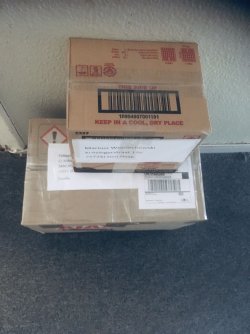Unfortunately I ship almost exclusively plecos. I am not sure how hey will do in breather bags. I have never received any fish in breather bags either (so far).
Also, how do you double bag breathers how does one meet the stupid requirements of both FedEx and UPS to use 4 ml bags and to double bag? I say stupid because it is very difficult to use bags that thing on smaller fish.
Finally, How does one ship a large number of fish in a box of breather bags? If you stack then so the bags in the center are all up against other breeder bags, how do those "buried" bags get air?
I do know when I worked with a partner years back to import essentially 350 plecos, mostly zebras, there were 7 boxes each containing 50 fish. My partner did the clearing and receiving and I covered the cost. He told me the fish were all individually bagged. This was done using a machine which bags fish and seals the bags.
I received and order which was supposed to contain 100 almost 2 inch zebra plecos and 15 L173 plecos of similar size. They travelled from Euerope to California and then to me in NY. They arrive, to me sent airport to airport, in just two bags. There were only 99 zebras in one bag and the 15 other fish in another. Unfortunately ther was one DOA L173 and 3 DOA zebras. I lost one more zebra during unbagging. I was refunded for the 5 dead fish. That is a loss rate of 4.34%. (Note: The 99 zebras in a huge double bag which contained about 3 inches of water and about 20 inches of air.)
When considering the distance the fish travelled and the time it took, that is not a bad result. I am never happy to have fish I sent or fish sent to me die, but I am also a realist. There are a number of things along the way we cannot control and the goal is to lose the fewest fish possible. Of course 0 is ideal but also not practical when the numbers involved are large.
When I ship fish I purge them first, i.e. they are not fed for a day for smaller fish and 2 or 3 for bigger ones. This should reduce the pooping along the way. I used to put a bit of dechlor/ammonia detoxifier into the bags until I learned these things are both reducing agents- they use up some of the oxygen in the water. I learned almost 15 tears ago from my friend Rachel O. to use a piece of Poly-Bio Marine Poly Filter in every bag.
Another important and patented feature of the "Poly Filter" is its unique ability to change a different color with the absorption of specific pollutants. It turns blue with a copper salt, light green to aqua with free copper, orange with iron, red with aluminum, yellowish green with ammonia and white to beige to brown to black with the absorption of harmful organics.
https://www.poly-bio-marine.com/
Most of the time my fish arrive at their destination with the Poly either white or a bit browned because it has absorbed organics (like a bit of fish poop).
I can also say it has been well a over a decade since anything I shipped contained any DOAS. But the fish I have spawning and which I sell to cover my hobby costs are expensive and I am not a business. So, I am not shipping tons of fish, just ones that are expensive and it is a lot harder on a seller and buyer to lose anything when the fish involved can cost up to several $100 each.
In the past month I have shipped a total of 53 fish in 4 boxes with 100% arriving alive and healthy. A lot of these were fish at least 3 inches and with spikey fins. I can also say that I hate shipping fish despite being pretty good at it. If a buyer is able/willing to pick up, I usually discount the price by about 20%. I have had a few buyers fly in from as far away as Kansas City for that savings.
Considering how many fish I have sent and received and none in breather bags, I wounder how widespread their use is. I know some folks swear by them but I not so sure they are getting either a larger number of fish or larger size fish. I think these bags are best for smaller fish and fewer in number being sent.








